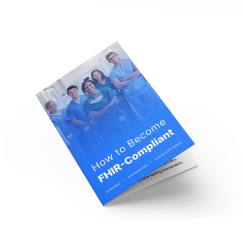Today, we are going to bite into some great FHIR use cases because it is not just another acronym. The FHIR standard brings a breath of fresh air to the healthcare industry, making data exchange smoother than ever.
While Fast Healthcare Interoperability Resources adoption is on the rise among healthcare software providers, it remains a complex journey with its share of challenges. Navigating the path entails delving into intricate specifications, ensuring data consistency, prioritizing security, and addressing a host of other hurdles.
Fortunately, with professional support and guidance from Binariks, this journey can be much easier. Our team has already aided numerous healthcare providers in successfully adopting FHIR. In this article, we will explore FHIR uses and its overall impact on healthcare.
The role of HL7 FHIR
HL7 FHIR is a modern interoperability standard developed by Health Level 7 (HL7). FHIR's mission is to streamline health data exchange, from clinical information to administrative records.
In 2012, a group of health IT experts, led by FHIR's inventor Grahame Grieve, asked a transformative question: "What would health information exchange look like if it started today, leveraging modern approaches?". This led to the creation of FHIR, simplifying data exchange with familiar web technologies like JSON and XML and providing a flexible, adaptable framework for modern healthcare.
But what is FHIR used for?
There are numerous applications of FHIR. By uniquely tagging each data element, akin to web page URLs, FHIR facilitates seamless data access across devices. This fosters the development of interactive applications for easy and consistent access to healthcare info, regardless of the EHR in use.
FHIR can be used for streamlined integration, quicker access to readable medical records, standardized data for automated clinical support, and reduced time for sharing document-based information.
How to become FHIR-compliant
A detailed approach to FHIR implementation

6 use cases of HL7 FHIR
Personal health record
Managing and accessing personal health records across different healthcare providers and systems is often fragmented and challenging for patients.
FHIR's role: FHIR integration enables the seamless exchange of health data, making it easier for patients to aggregate and access their personal information. With standardized data formats and APIs, patients can have a holistic view of their health from various sources, improving care coordination and informed decision-making.
Healthcare document sharing
Sharing healthcare documents, such as medical records, between healthcare institutions and providers can be slow, cumbersome, and error-prone.
FHIR's role: FHIR streamlines document sharing by providing a structured and standardized format for healthcare documents. This ensures that critical information is accurately and efficiently exchanged between different systems.
Clinical decision support
Healthcare professionals often face information overload when making clinical decisions. They need quick access to evidence-based guidelines and patient-specific data.
FHIR's role: FHIR helps clinical decision support systems by structuring patient data. It allows these systems to integrate seamlessly with EHRs, providing real-time, relevant information to aid healthcare providers in making informed decisions, ultimately enhancing patient safety and care.
Public health surveillance
Public health organizations need timely and accurate data to monitor disease outbreaks, track health trends, and respond to health emergencies.
FHIR's role: FHIR implementation helps standardize public health data exchange, making it easier for healthcare facilities to report relevant data to public health authorities. This streamlines surveillance and response efforts, allowing quicker interventions and better population health management.
Clinical research
Clinical research often involves collecting, aggregating, and analyzing data from various sources, which can be a time-consuming and error-prone process.
FHIR's role: FHIR facilitates data sharing between research institutions, EHRs, and other systems. Researchers can access structured data from diverse sources, accelerating the research process and supporting advancements in medical science, illustrating the uses of HL7 FHIR.
Patient engagement
Engaging patients in their own healthcare and treatment plans is crucial, but it can be challenging to provide them with accessible and understandable health information.
FHIR's role: FHIR promotes patient engagement by enabling the development of user-friendly healthcare apps and portals, demonstrating yet another valuable use case for FHIR. Patients can access their health data, receive personalized health information, and actively participate in their care, leading to better health outcomes.
HL7 FHIR stands at the forefront of modern healthcare as a versatile and indispensable solution. From empowering patients with easy access to their personal health records and streamlining document sharing to enhancing clinical decision support, facilitating clinical research, and promoting patient engagement.
Supporting a wide range of healthcare initiatives
- Interoperability: FHIR promotes interoperability, ensuring that healthcare systems, devices, and applications can communicate and share data efficiently. It paves the way for holistic patient care by breaking down data silos.
- Telemedicine: In the era of telemedicine, FHIR enhances remote healthcare delivery. It facilitates the exchange of patient information, allowing physicians to make informed decisions regardless of geographical constraints.
- Digital health: FHIR enables the development of user-friendly health apps and devices. It empowers individuals to take control of their health data, fostering better health management.
- Value-based care: FHIR supports value-based care models by providing real-time access to patient data, aiding healthcare professionals in delivering high-quality, cost-effective care, and improving patient outcomes.
FHIR's versatility and adaptability make it a cornerstone for addressing the use cases of FHIR in healthcare, such as promoting interoperability, enhancing telemedicine, advancing digital health, and enabling innovations like SMART on FHIR .
Real-life workflow examples
CoxHealth
At CoxHealth, a Missouri-based health system, a shortage of dermatologists led to a unique challenge. With primary care physicians stepping in to perform dermatology exams, the lack of specialized expertise was evident. However, a FHIR-powered solution came to the rescue.
Through a SMART on FHIR application named VisualDx, these doctors gained access to cutting-edge resources like medical imaging, visualization, and machine learning. This empowered them to compare variations of skin, hair, and nail conditions, resulting in more accurate diagnoses.
The SMART framework, designed for compatibility with every healthcare system, allows clinicians, patients, and innovators to seamlessly integrate apps. VisualDx is now seamlessly integrated into CoxHealth's Cerner EHR, saving physicians valuable time. With essential patient data readily available, physicians can make informed decisions based on age, gender, medications, and existing conditions.
Plus, the mobile accessibility of VisualDx ensures that physicians are always connected to patient data, whether they're in the office or on the go. This dynamic tool not only aids in differential diagnoses but also equips physicians with in-depth knowledge about various medical conditions (Source ).
The Joint Commission
The Joint Commission harnesses the FHIR standard to extract quality metric data from member organizations, like surgical facilities, using the Health Quality Measures Format (HQMF).
With the help of IBM's Operational Decision Management software, equipped with Business Event Processing capabilities, The Joint Commission runs this data through a specialized quality rules engine. This engine not only analyzes quality data formats but also generates reports and rankings for members and government organizations.
Furthermore, The Joint Commission aims to expand upon a prior HL7 project. This initiative uses FHIR to specify quality metric data and measurement rules (Source ).
The Gravity Project
Health outcomes are significantly shaped by social determinants – factors linked to where people live, learn, work, and play. Healthcare standardizes and utilizes data related to these determinants.
Partnering with over 800 stakeholders, The Gravity Project is developing guidelines for capturing data on food security, housing stability, and transportation access using the FHIR standard. This collaboration is part of the HL7 FHIR Accelerator Program, enabling seamless integration between healthcare and social care data.
FHIR's structured data exchange capabilities will support standardized documentation and sharing of social determinants data, paving the way for data-driven decision-making and public health efforts.
Improved interoperability for a healthcare referral platform
Revamping solution architecture and enabling interoperability with FHIR
How we use FHIR
In this section, we'll dig into the practical side of FHIR by showcasing how we put it to work with our clients. These real-life cases highlight the impact of FHIR in action.
Non-emergency medical transportation company
Our client specializes in in-home care services, including non-emergency medical transportation benefits, with a focus on predicting Electronic Health Information (EHI) exchange and integration with insurance companies and Third Party Administrators (TPAs).
They operate a market network platform connecting caregivers and members based on insurance benefit plans, along with offering automation for Health Information Technology (HIT), logistics, utilization, and quality management.
Binariks proposed a solution focused on adopting FHIR as centralized health data storage. This enabled secure interoperability and faster data exchange. The plan included achieving HIPAA compliance, facilitating FHIR-based integration, enhancing scalability, implementing OAuth authentication, and activating Transport Security TLS 1.2.
Collaborating with Binariks brought about automated claim submission, real-time data access, and increased scalability. The enhanced solution offers secure, efficient data hosting, streamlined insurance registration, and long-term cost reductions.
Patient health monitoring application
One of our clients is an innovative player in digital health, working on a speech-processing platform for monitoring patients' health using speech analysis via mobile devices and voice-activated assistants. Their app, tailored for Congestive Heart Failure (CHF) patients, offers continuous health monitoring in the US healthcare market.
The client's existing non-commercial app, designed for elderly patients to detect cardiovascular and lung disease risks, needed enhancement for US market entry and FHIR compliance. This involved addressing data security and diverse regulations for integration with hospital systems.
Our team optimized onboarding processes, introduced a multi-tenant approach, and implemented Single Sign-On (SSO) architecture to meet FHIR security standards. We streamlined onboarding, selected integration solutions, and facilitated effective communication between the client and hospitals.
Binariks provided a comprehensive FHIR integration plan, equipping the client for a successful US market entry while adhering to stringent security regulations, and offering a clear roadmap for transition.
Healthcare referral platform
Our client operates a cloud platform that simplifies doctor referrals and enhances patient care by enabling seamless e-referrals across various Electronic Health Records (EHR) systems through secure FHIR-API exchange.
The client sought to integrate with multiple EHR providers while complying with the 21st Century Cures Act and HIPAA regulations. Binariks' team, including engineers and business analysts, streamlined the e-referral process, ensured HIPAA compliance, and selected Epic as the preferred EHR provider, supporting SMART on FHIR.
This implementation now facilitates secure patient data exchange among medical providers, with over 1.7 million searchable medical profiles and compliance with ONC regulations, streamlining healthcare processes and decision-making.
Final thoughts
FHIR has revolutionized healthcare data exchange, bridging gaps between various stakeholders and systems. Whether it's enhancing interoperability, supporting quality healthcare initiatives, or bringing the power of real-world FHIR use cases to life, the impact of this standard is profound.
As we conclude this journey, we're reminded of the immense potential FHIR holds in improving healthcare on a global scale. The use cases, challenges, and accomplishments showcased here represent just a fraction of what FHIR has to offer.
With Binariks as your trusted partner, your organization can join the vanguard of the FHIR revolution, bridging the gap to more efficient, secure, and patient-centric healthcare services.
FAQ
Share

